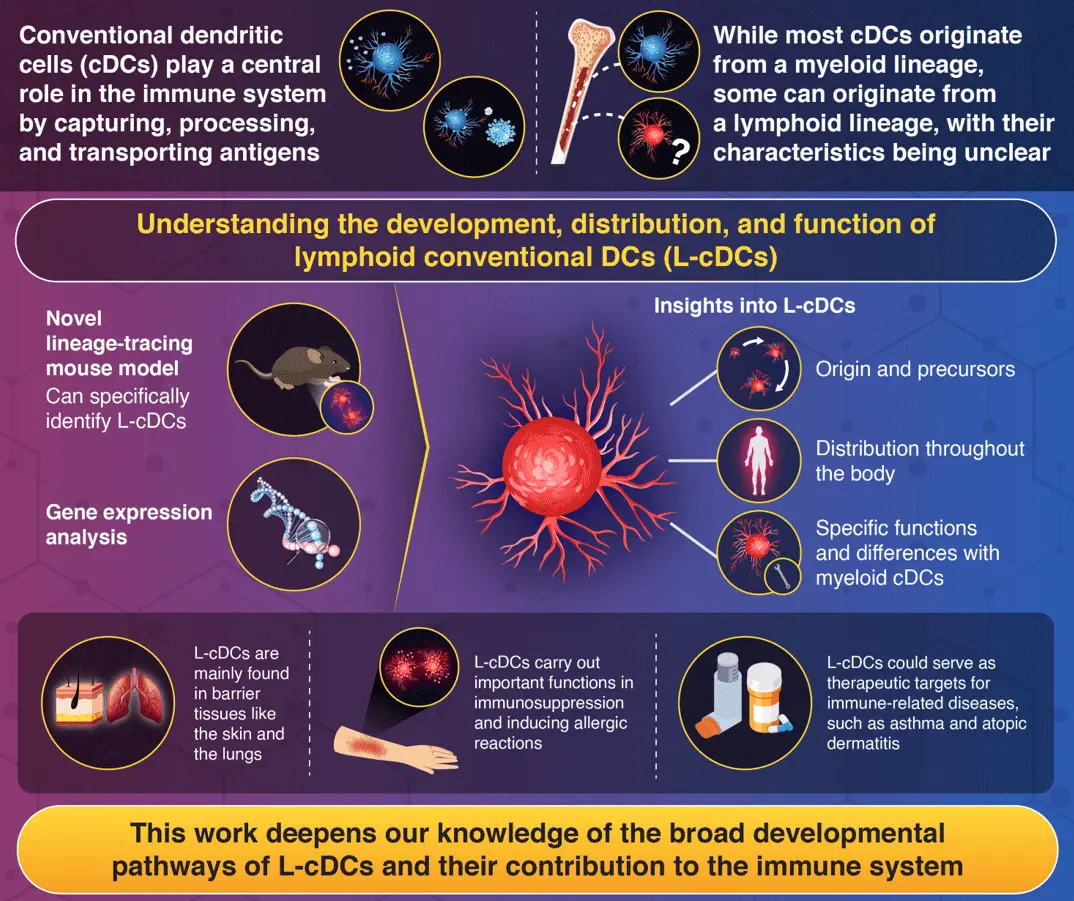Lymphoid-derived conventional dendritic cells (L-cDCs) may play a unique function associated with immune suppression and allergy induction, as reported by researchers from Japan. Long thought to arise only from myeloid lineages, cDCs were found to also originate from lymphoid progenitors. Using fluorescent reporter mice, the team tracked L-cDCs throughout the body, revealing their abundance in barrier tissues like skin and lungs and their distinct genetic signatures and functions.
Deep Look into an Underexplored Lineage of Immune Cells

Kanayama et al. (2025) | Science Advances | 10.1126/sciadv.adt4909
Conventional dendritic cells (cDCs) are essential components of the immune system, acting as primary orchestrators of adaptive immunity. These specialized cells capture and process antigens and then present them to white blood cells called T cells, thus initiating robust immune responses. This is a critical process for fighting off infections and cancers and is also implicated in autoimmune disorders. Scientists broadly understood that in the physiological environment, most cDCs originate exclusively from myeloid lineage cells, a well-established developmental pathway in immunology.
However, recent evidence suggests that cDCs can also develop from lymphoid lineages-the cellular family that includes T cells, B cells, and natural killer cells. The precise developmental pathways, tissue distribution patterns, and specific functional roles of these lymphoid-derived cDCs (L-cDCs) remain unclear and are a subject of ongoing scientific debate.
To address this knowledge gap, a research group led by Professor Toshiaki Ohteki from the Institute of Integrated Research at Institute of Science Tokyo (Science Tokyo), Japan, explored the lesser-known world of L-cDCs. Their latest paper, published in Science Advances on June 6, 2025, in Volume 11, Issue 23, reveals interesting characteristics of this underexplored population of immune cells.
The researchers genetically engineered 'reporter mice' expressing fluorescent tags, which enabled them to accurately track lymphoid lineage cells throughout the body. Using this platform, they discovered that while L-cDCs constitute only a minor population in general lymphoid tissues, they are abundant in barrier tissues such as the lungs and skin. Through comprehensive gene expression analyses, the team further confirmed the lymphoid lineage of the identified L-cDCs, revealing specific lymphocyte signature genes. "These lymphoid-derived cDCs exhibited potent functions in immune suppression and allergy induction and appear to follow diverse developmental pathways," remarks Ohteki.
Functionally, L-cDCs displayed distinct characteristics compared to their myeloid-derived counterparts. Under conditions of low antigen stimulation, L-cDC2s (a specific subtype of L-cDCs) showed a reduced capacity to activate T cells. However, when faced with sufficient antigen stimulation, L-cDC2s preferentially promoted T helper 2 (TH2) differentiation. This dual functionality, namely a high threshold for T cell activation combined with a strong TH2-promoting capacity, highlights their potential role in maintaining both tissue homeostasis and driving allergic responses.
Together, these findings pave the way to a more comprehensive understanding of the immune system. The results suggest that L-cDCs could serve as promising therapeutic targets for TH2-related diseases such as asthma and atopic dermatitis, where the uncontrolled TH2 responses contribute to pathology.
Furthermore, the existence of cDCs originating from both myeloid and lymphoid progenitors that perform similar core functions points to a fascinating biological phenomenon. "In evolutionary biology, the evolution of independent organisms with similar traits from different lineages in a particular environment is known as convergent evolution, as seen in the morphology of dolphins and sharks," first author Kanayama explains. "The development of cDCs from myeloid and lymphoid progenitors implies the existence of convergent evolution at the cellular level. Directing future research, whether such convergent evolution is a phenomenon limited to the immune system or is also observed in other systems, will provide us with remarkable answers."
Further research will hopefully uncover additional roles these cells play in immunity and cellular biology.
Reference
- Authors:
- Masashi Kanayama1, Yuta Izumi1, Nobuyuki Onai2, Takako Akashi1, Yuichi Hiraoka3,4, and Toshiaki Ohteki1*
- Title:
- Diverse developmental pathways of lymphoid conventional dendritic cells with distinct tissue distribution and function
- Journal:
- Science Advances
- Affiliations:
-
1Department of Biodefense Research, Medical Research Laboratory, Institute of Integrated Research, Institute of Science Tokyo, Japan
2Department of Immunology, Kanazawa Medical University, Japan
3Laboratory of Genome Editing for Biomedical Research, Medical Research Institute, Tokyo Medical and Dental University, Japan
4Laboratory of Animal Resource, Center of Disease Biology and Integrative Medicine, Graduate School of Medicine, The University of Tokyo, Japan






